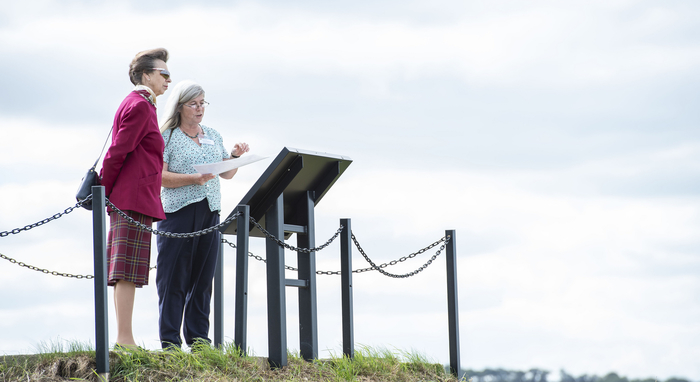HRH The Princess Royal visited the Devon campus of Rothamsted Research today to hear about a new chapter in sustainable livestock production and the 60-year heritage on which this development builds.
Sheep and cattle were the focus of royal attention today, along with the science of raising such livestock sustainably to reduce their environmental impact, when HRH The Princess Royal visited the agricultural research campus of Rothamsted Research at North Wyke, near Okehampton in Devon.
The Princess Royal joined celebrations of more than half a century of livestock research at North Wyke, which brings together many local and regional researchers, farmers and small businesses, and heard about plans for a new, £2 million research facility to support the UK’s sheep industry.
The Small Ruminant Research Facility, due to be in place early next year, will address policy and industry needs around sustainable ruminant livestock production using sheep as a model for all ruminants. This is important because often the cost of initial investigations in dairy or beef cows can be prohibitive.
“This state-of-the-art facility will be invaluable for the next generation of livestock science researchers to analyse, at a farm system scale, the impact of management decisions on sheep productivity at the level currently afforded to cattle,” says Professor Michael Lee, Head of Sustainable Agricultural Sciences at North Wyke.
Professor Lee, who is also Professor of Sustainable Livestock Systems at Bristol Veterinary School, hosted The Princess Royal alongside Professor Achim Dobermann, director and chief executive of Rothamsted Research, which is itself marking 175 years since the start of agricultural research at its campus in Hertfordshire in 1843.
“We have been delighted to welcome The Princess Royal to our Devon campus today,” says Professor Dobermann. “Her Royal Highness was keen to find out more about every aspect of the research that takes place here.”
“She has bamboozled us with her knowledge,” adds Professor Lee.
The visit provided an opportunity to bring together many of the academic, industry and farming stakeholders who have helped contribute to the research at North Wyke. They continue to support the need for research in the livestock sector, which contributes over £8 billion a year to the UK economy.
“As The Princess Royal unveiled a plaque to commemorate her visit,” says Professor Dobermann, “Her Royal Highness told an audience of friends and colleagues of North Wyke, that what is so valuable here is our ability to produce information for farmers for whatever farm system they happen to be using, and to be able to measure accurately and appropriately.
“Her Royal Highness reminded us that Rothamsted’s reputation and experience are older and longer than most, in terms of agricultural research, and that it’s a huge encouragement to those who still farm, under whatever heading, that there are people in research who are genuinely keen to understand the problems and to find practical answers that are applicable to those who actually work on the land.”
Professor Lee adds: “The new facility is a testament to Rothamsted’s commitment to the need to address issues of food security, and research on grazing livestock systems in particular, and will provide vital, evidence-based support for the UK sheep industry for decades to come.”
The facility will open up new areas of investigation. It will enable detailed animal feeding trials on grassland systems to be monitored using a range of instrumentation across the entire production season. There is scope to cover 600 ewes and their lambs, their feed and the land they graze on.
The findings will help farmers to make informed decisions about when animals require supplemental or residual feed, and the best feed to use to maximise production from pasture. The overall aim is efficient production, reduced greenhouse gas emissions, and better silage with maximum availability of minerals.
Investment in the new facility has come from Rothamsted, the Biotechnology and Biological Sciences Research Council (BBSRC) and the Centre of Innovation Excellence in Livestock (CIEL), which is one of the UK’s four agri-tech centres.
There is increasing recognition of the vital role that grazing livestock play in a healthy agricultural system, in boosting soil fertility and in helping to sequester carbon in carefully managed pastures, all part of sustaining a circular economy.
Livestock industries are seeking advice on how best to raise livestock on land that is not suitable for arable crops, either by growing crops for animal feed or by using the land for grazing. This sort of land can be difficult to manage sustainably; it can waste nutrients, which can pollute waterways, for example.
And this is where Rothamsted’s North Wyke Farm Platform (NWFP) provides a unique resource; a way to establish how best to use such land in an environmentally sustainable manner to produce high quality food, either directly through grazing or indirectly by growing food for animals.
Three “farmlets” make up the farm platform. They provide real-world, farm-scale models that enable researchers, farmers, and industry to compare and contrast a variety of approaches to raising livestock sustainably, and the data to support their findings.
“Her Royal Highness was very interested in how we manage the inputs and outputs and, in particular, the cattle and sheep on our farmlets,” says Dr Jane Hawkins, a specialist in soil and water science at Rothamsted.
“The Princess Royal wanted to know more about how we are monitoring all the metrics of the farm platform, and about the land management before the platform was established, in particular the grass species that were here originally, and how those compare with our current permanent pasture,” adds Dr Hawkins.
Research at North Wyke is helping to address some of agriculture’s most pressing challenges, such as mitigating and adapting to climate change, protecting natural resources, maintaining food security, and sustaining the pasture-based livestock systems that are dominant in regions such as the South West of England.


